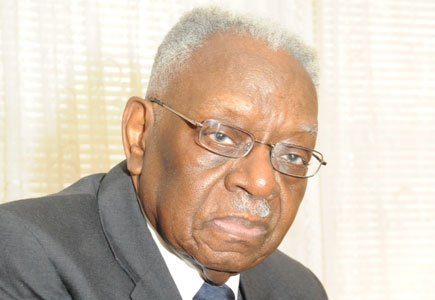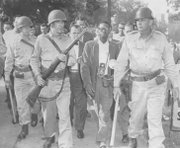This is part one of a three-part series on longtime journalist Moses J. Newson. Newson, 87, was inducted into The National Association of Black Journalists (NABJ) 2014 Hall of Fame earlier this year for his outstanding contributions to the industry.
During his long and distinguished journalism career, 87-year-old Moses Newson covered many memorable stories including the “Freedom Rides” and the Emmett Till murder trial in Mississippi. Reflecting back over his “storied” career, Newson rewound the hands of time back to his most memorable interview.
(Courtesy Photo)
Newson being escorted away from a location near Central High School by Arkansas National Guard troops in 1957.
“I interviewed Dr. Martin Luther King, Jr. shortly before he was assassinated,” said Newson. “At the time he was in Atlanta, and was being driven to the airport by Harry Belafonte. Coretta Scott King and Andrew Young were in the car as well. They were on their way to a conference in Washington, DC. At the time, Dr. King was under heavy criticism for his position on Vietnam, poverty in the country, and J. Edgar Hoover was bugging him.”
He added, “Sometimes, you get criticized for trying to do more. Dr. King was telling me how sad it was that he was being criticized by some of the Civil Rights leaders for just trying to do the right thing. He said he was going to keep pushing. Nobody’s perfect, but Dr. King was quite a guy.”
Newson recalls the memorable ride with Dr. King, who was assassinated in 1968; Dr. King’s wife, Coretta, who passed away in 2006; musician, actor, and activist Belafonte; and politician and activist Young, as if it were yesterday.
Capturing the interview with Dr. King, along with covering stories such as the “Little Rock Nine,” the nine African American students involved in the desegregation of Little Rock Central High School in Little Rock, Arkansas, allowed Newson to address what he felt was a great need in the black community.
“Changes needed to be brought about regarding segregation in this country,” said Newson. “Black publications such as the Baltimore AFRO-American Newspaper, the Pittsburgh Courier, and other black press seemed to be a great avenue to bring about changes that were obviously needed.”
He added, “I came out of school, and in the summer of 1952 after serving 27 months in the Navy I started working with The Tri-State Defender. During that time, I had the opportunity to serve with the paper’s editor, L. Alex Wilson.”
Wilson, was the editor and general manager of The Tri-State Defender of Memphis, Tennessee, the southern outpost of The Chicago Defender. A few years later, Newson and Wilson were among the contingency of the black press who traveled to Arkansas to cover the Little Rock Nine.
“It was my first job for the Baltimore AFRO-American Newspaper,” recalled Newson. “In addition to myself and Wilson, there was Jimmy Hicks, editor of the Amsterdam News of New York, and photographer Earl Davy.”
Newson, Wilson, Hicks, Davy, and other members of the black press not only braved the dangerous back roads of the South as they traveled to report on lynchings and other stories, but put their lives on the line once they arrived to covered them. The sidewalks and streets surrounding Central High was dangerous territory for the black press, and even the white media covering the Little Rock Nine. Angry whites arrived every morning to demonstrate their disapproval of integration.
“There was a big mob out there,” recalled Newson. “People were on both sides of the street. We were called names and threatened, but at some point, someone yelled that the kids had to get down to the school and we were attacked. But Wilson refused to run. He was from Florida and had been chased down there by the KKK. After that, he promised he would never run again. Wilson took quite a beating. He refused to run and really got clobbered. He was kicked and hit in the head. Wilson died a few years later. His wife thought the beating might have contributed to his death.”
He added, “Every situation was different. I was born and reared in the South and had a good idea of how dangerous things might be. You never knew exactly what you might run into. However, once you decide you are going to do those things, you just go out and do them.”
He added, “Some situations were quite challenging. There were times you knew you would rather be someplace else. However, it was important for black men to be on the scene to cover things that were important to the black community.”
Part two of this series will continue with more about the landmark events that Newson covered during the Civil Rights era, the struggles of today, and his induction into The National Association of Black Journalists (NABJ) 2014 Hall of Fame.
-30-

